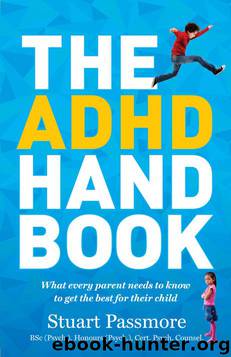The ADHD Handbook by Stuart Passmore

Author:Stuart Passmore
Language: eng
Format: epub
Tags: Family & Relationships/Children with Special Needs
ISBN: 9781775591559
Publisher: Exisle Publishing
Published: 2009-01-01T00:00:00+00:00
MINDFULNESS
Mindfulness is a treatment that in recent years has begun to receive ever-increasing attention by medical practitioners and mental health specialists alike and, as such, has been trialled for a number of different medical and psychological disorders with some degree of success. Mindfulness has also been trialled with sufferers of ADHD with mixed results. While the research involving the effectiveness of mindfulness on ADHD symptoms is not vast, it is included in this chapter because of the current attention it is receiving as a possible alternative or complementary treatment to medication.
As you are no doubt aware, some of the more problematic issues of ADHD are the difficulties children (and adults) have in maintaining their attention over a prolonged period of time, the trouble they experience making and holding plans and keeping goals in mind, and the difficulty they experience in restricting impulsive responses. Mindfulness is a relatively new adaptation to therapy in Western culture, but as its origins are steeped in Buddhist meditation and Eastern mysticism, mindfulness has a rather long history of some 2500 years.
Mindfulness has been used with adults suffering from depression, pain, anxiety disorders and eating disorders. It has also been claimed that the practice of mindfulness can reduce aggression. Mindfulness is about paying close attention to the present or the in-the-moment experience to increase awareness of the present moment, enhance non-judgmental observation, and to reduce automatic responding. Mindfulness is a type of meditation with an emphasis on observation rather than a reaction to your thoughts, emotions or body states. Mindfulness, it is argued, teaches the individual to become less reactive to what is happening to them in the present moment. So, whether the situation you find yourself in is a positive one or a negative one or even neutral, you can be less reactive to that situation. Another way of describing mindfulness is that you are taking no steps to change the current situation; you are simply observing it. This observational response then enables the person to reduce their general level of suffering (be it physical or emotional pain) and increase a general sense of wellbeing.
Download
This site does not store any files on its server. We only index and link to content provided by other sites. Please contact the content providers to delete copyright contents if any and email us, we'll remove relevant links or contents immediately.
I Capture the Castle by Dodie Smith(1905)
Aspergirls by Rudy Simone(1585)
Be Different by John Elder Robison(1558)
Autism's False Prophets by Paul A. Offit(1450)
My Child's Different by Elaine Halligan(1428)
Smart but Scattered—and Stalled by Richard Guare(1414)
101 Tips for the Parents of Boys with Autism by Ken Siri(1382)
What's Making Our Children Sick? by Michelle Perro(1350)
Asperger Syndrome (Autism Spectrum Disorder) and Long-Term Relationships by Ashley Stanford(1331)
ADHD by Mark Selikowitz(1304)
Girlish by Lara Lillibridge(1294)
Nerdy, Shy, and Socially Inappropriate by Cynthia Kim(1272)
An Adult with an Autism Diagnosis by Gillan Drew(1265)
On Immunity: An Inoculation by Biss Eula(1245)
Animal-assisted Interventions for Individuals with Autism by Temple Grandin(1223)
Sarah's Child (Hqn Romance) by Linda Howard(1221)
Seeing Ezra by Kerry Cohen(1199)
Why Gender Matters by Leonard Sax M.D. Ph.D(1184)
The Cities by K.A Knight(1178)
